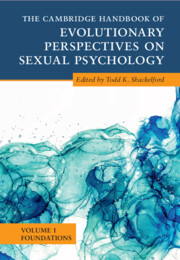Book contents
- The Cambridge Handbook of Evolutionary Perspectives on Sexual Psychology
- The Cambridge Handbook of Evolutionary Perspectives on Sexual Psychology
- Copyright page
- Contents
- Contributors
- Preface
- Part I Foundations of Evolution
- Part II Middle-Level Theories
- 7 Parental Investment Theory
- 8 Parent–Offspring Conflict
- 9 Theory and Evidence for Reciprocal Altruism
- 10 Life History Theory and Mating Strategies
- 11 Sperm Competition Theory
- 12 Sexual Conflict Theory
- 13 Cross-Species Comparisons
- 14 Cross-Cultural Methods in Sexual Psychology
- 15 Behavioral Genetics
- 16 Sex Differences and Sex Similarities
- 17 Individual Differences in Sexual Psychology
- 18 Experimental Methods in Sexual Psychology
- Index
- References
12 - Sexual Conflict Theory
from Part II - Middle-Level Theories
Published online by Cambridge University Press: 30 June 2022
- The Cambridge Handbook of Evolutionary Perspectives on Sexual Psychology
- The Cambridge Handbook of Evolutionary Perspectives on Sexual Psychology
- Copyright page
- Contents
- Contributors
- Preface
- Part I Foundations of Evolution
- Part II Middle-Level Theories
- 7 Parental Investment Theory
- 8 Parent–Offspring Conflict
- 9 Theory and Evidence for Reciprocal Altruism
- 10 Life History Theory and Mating Strategies
- 11 Sperm Competition Theory
- 12 Sexual Conflict Theory
- 13 Cross-Species Comparisons
- 14 Cross-Cultural Methods in Sexual Psychology
- 15 Behavioral Genetics
- 16 Sex Differences and Sex Similarities
- 17 Individual Differences in Sexual Psychology
- 18 Experimental Methods in Sexual Psychology
- Index
- References
Summary
Sexual conflict arises from differences in the fitness interests of males and females. A trait that is beneficial for the reproductive success of one sex reduces the fitness of the other sex, resulting in opposing selection pressures on the two sexes. The two sexes need each other for reproduction, but their dependence is asymmetric. Males benefit from a higher mating rate than females, as their reproductive success is usually constrained by the number of receptive mates, while female reproductive success is limited by egg production. Sexual conflict can occur at any stage of reproductive interactions – before or during copulation, or after insemination – and over almost any aspect of reproduction, from the decision to mate to the investment into parental care. The conflict results in a perpetual tug of war between the sexes. Each sex attempts to maximize its fitness at a cost to the other sex, which results in sexually antagonistic selection. This can cause the rapid evolution of sexual traits, and ultimately results in the diversification of traits, and possibly even in speciation. Sexual conflict can manifest in two ways, intra- and interlocus sexual conflict. Intralocus sexual conflict occurs when a trait expressed in both sexes (determined by alleles in the same locus in the two sexes) has opposite effects on male and female fitness. Interlocus sexual conflict occurs when the conflicting traits are determined by alleles in different loci in the two sexes and the optimal outcome of male–female interactions differs between the two sexes. Intralocus sexual conflict generates a genetic tug of war between the sexes over the optimal trait expression, while interlocus sexual conflict can lead to open-ended cycles of sexually antagonistic coevolution. Sexual conflict before mating has resulted in a diversity of tactics and strategies that males use to overcome female unwillingness to mate, from forced copulations and sneaky fertilization to the emission of love darts. Sexual conflict after mating has favored the evolution of male traits that increase success in sperm competition, such as postcopulatory mate guarding, toxic seminal substances that destroy the sperm of other males, mating plugs that prevent other males from mating with the female, and morphological and physiological traits that harm females, such as spines on the intromittent organ that pierce the reproductive tract of the female. Females have evolved cryptic choice of sperm to influence which males fertilize her ova. Whether the sexual conflict between males and females can be resolved depends on the type of conflict. Several mechanisms may reduce the strength of intralocus conflict, such as sex-limited expression of traits, but the interests of males and females are unlikely to become aligned when it comes to interlocus conflict. The relative influence of sexual conflict on the fitness of organisms, and the degree to which it can be resolved, are open questions.
Keywords
- Type
- Chapter
- Information
- Publisher: Cambridge University PressPrint publication year: 2022



